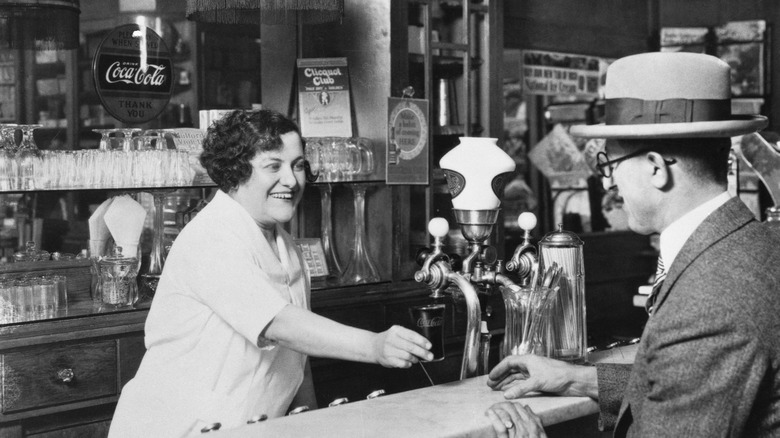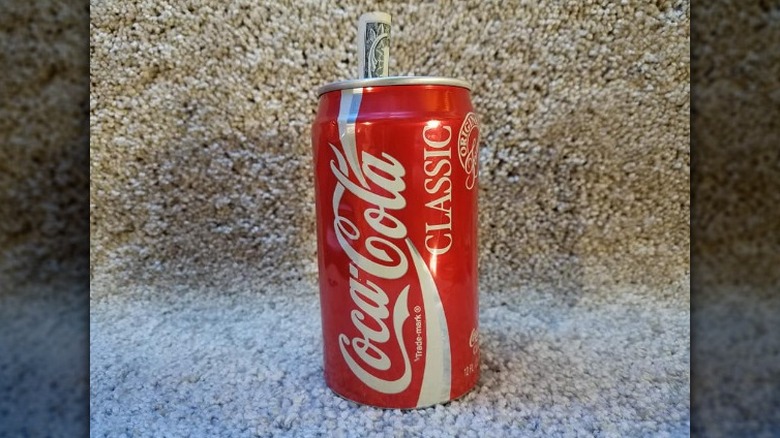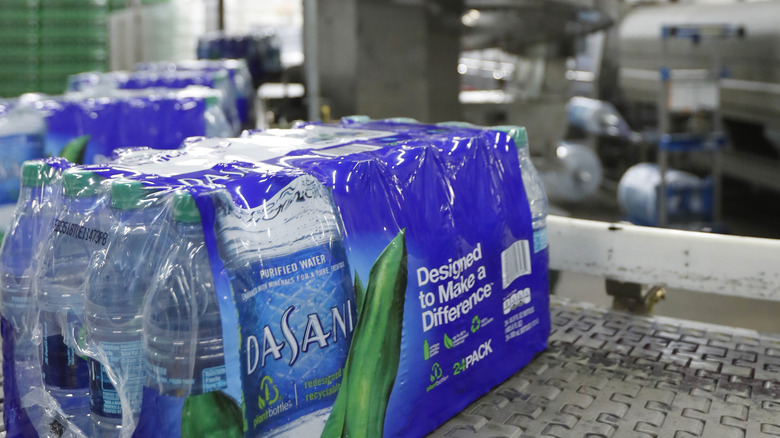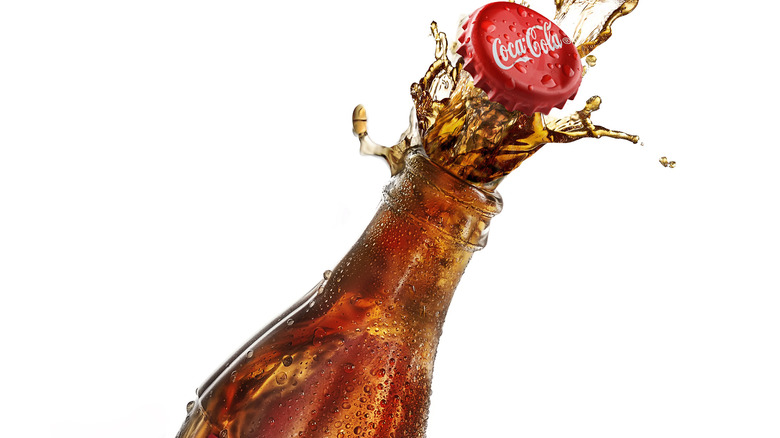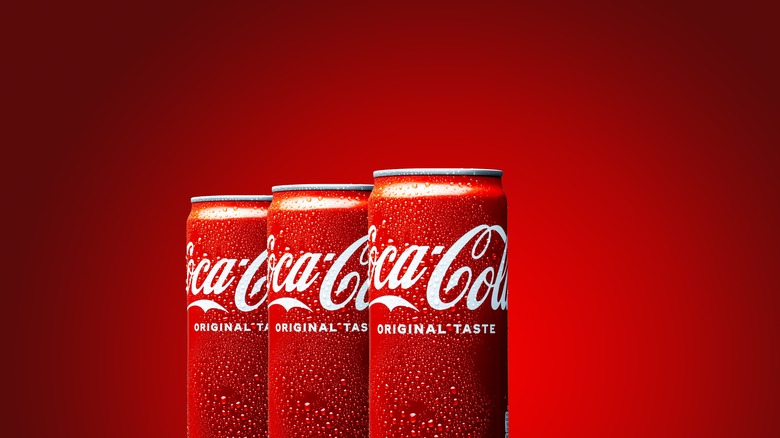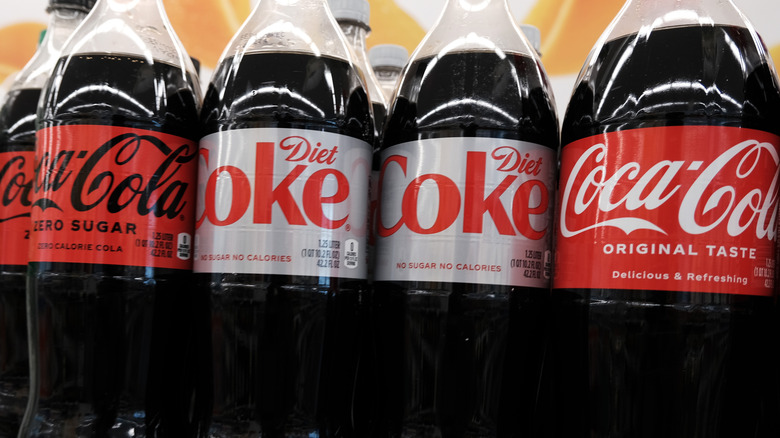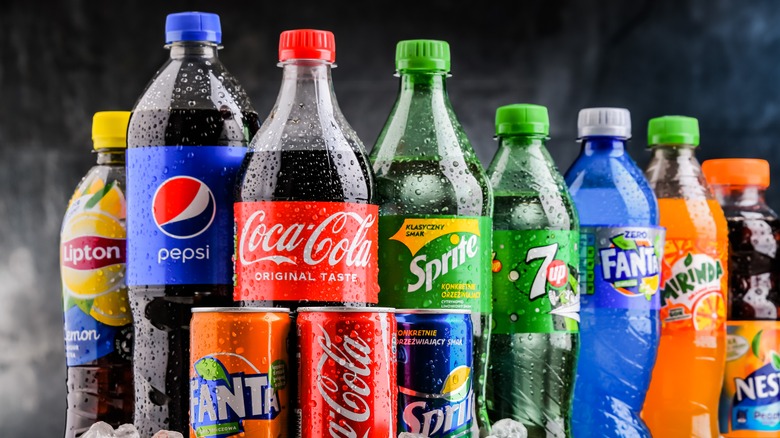The Untold Truth Of Coke
Coca-Cola has reached a level of brand-recognition shared only by a few other companies (and that most can only dream of). There's Disney with their Mickey Mouse ears, Apple with a bitten apple, the golden arches of McDonald's, and Coca-Cola with that bright red can or bottle. You'd know those brands anywhere, right? Who hasn't had a Coke and a smile? There aren't many places you can't grab a Coke — if you're driving through Burkina Faso and get a craving for a Coke, guess what?
You can pick one up in Ouagadougou. That's the kind of power Coke yields; when space aliens land on Earth, they'll be like "Oh, you guys have Coke too? That's cool." Believe it or not though, there are still some things out there you didn't know about that soda from down south — and some of them are secrets that Coke probably wishes no one had ever discovered.
The real reason they took the cocaine out
There's a reason it's called Coca-Cola — the soda used to contain cocaine. This isn't some national secret, although Coca-Cola tends to downplay it. There was a time when the drink was considered medicinal. Dr. John Pemberton put just enough cocaine in his new soda to give you a fix, and it was eventually named Coca-Cola. Coke removed the cocaine in 1903, but if you're thinking they had to, you're wrong. The US government didn't ban cocaine until 1914. So why did Coke jump the gun early? Racism.
Because Coke was so affordable — at around a nickel a bottle — anyone could buy a coke, and that included blacks. Whites feared "negro cocaine fiends" would rape white women, all hopped up on nickel Coca-Colas. Southern newspapers at the time spread the fear by reporting on gangs of black men high on cocaine taking liberties with proper Southern Belles. There is still coca in Coke today; but without the ecgonine alkaloid it's harmless.
Their MagiCans smelled like farts
In 1990, Coke poured a ton of money ($100 million, to be exact) into a campaign that left some customers with a bad taste—and an even worse smell—in their mouths. For this campaign, Coke's plan was to give away more than $4 million to customers by filling select cans with cash or prizes. These winning cans would be MagiCans, a new can designed specifically for this campaign. Though it would look like a normal Coke can on the outside, it was actually spring-loaded and would eject the prize as soon as the can was opened. So as to not feel different from other cans, the part of the MagiCan not containing the prize was filled with chlorinated water and ammonium sulfate (to discourage drinking).
Many of the mechanisms failed, and some unsuspecting "winning" customers drank the stinky water when their prizes failed to eject. It even landed one young boy in the hospital, though he was not seriously injured. Unfortunately, the bad smell gave Coke a lot of bad press, and the campaign was forced to end long before its allotted run time — and before all the MagiCans were discovered.
The UK wasn't having their tap water
In the US, we're willing to pay big bucks for what is essentially tap water in a plastic bottle. Coke found out the hard way that standards are a little higher in the UK — and that knowledge came at a big expense to the company. In the US, Coke has a hit with Dasani, bottled tap water that's purified and fortified with minerals. They tried to repeat that success in the UK in 2004, opening up a plant in London, but the company quickly became a running joke instead of the big seller they were hoping to be when locals discovered the bottled water was nearly the same as the tap water they could drink at home.
Matters became even worse when a mix-up at the plant contaminated some of the water with carcinogens, forcing a recall of all Dasani water in the UK and closing the UK plant for good. Within five weeks of their big UK debut, they were gone again — a major blemish on a company that's not too used to taking hits.
They hate the taste tests
If there's a real reason Coke tried a new formula in 1985, it's because Pepsi was on their heels. The general thought was that Americans' taste buds changed collectively, and the sweeter formula of Pepsi surpassed Coke. The evidence was overwhelming — Pepsi always won the Pepsi Challenge. Coke thought they needed to adjust to the new tastes, but what they really needed was science on their side.
The human brain is designed to like things sweeter to the taste. In other words, on the first sip of two products, let's say, Coke and Pepsi for example, the sweeter one is more pleasing. Over the course of a full beverage, like a can of Coke or a can of Pepsi, the tastes adjust slightly and a less sweet flavor will hit the spot. This applies to wines as well — in a quick sip, sweeter does better. Coke doesn't want to tell you exactly why, they just don't want you to take the one-sip test. That's also why Pepsi, despite all the challenges and all the winning results, never surpassed Coke.
Surge was the worst ever
Soda in general gets a bad reputation. It is actually a great thirst quencher, and who doesn't love a little caffeinated drink or 12 to get them through the day? But just when you're thinking it might not be so bad, somebody brings up Surge. The green slime — internally at Coke called the Mountain Dew killer — packs 330 calories 62 grams of carbs into a tiny 16 oz bottle. And to be honest, it didn't even taste good enough to justify the calorie splurge.
If there was a way to take the 1990s and put in a bottle, that bottle would be Surge. Yet despite that Surge made a comeback in 2014 because, well, you never know when a sanctioned sofa race will break out.
Thums Up
Despite Coke's world domination, there is one country where they don't have a complete stranglehold on the beverage community. In India, Coke can't hang with Thums Up — that's right, without the "b." But Coke still wins. In 1977, the Indian Government expelled Coke from the country (Pepsi too).
To fill the gap, Parle Agro produced a "Coke-like" product called Thums Up. What they lack in spelling, they made up with in domination, enjoying an 80 percent hold on all cola consumption. After 16 years, the Indian people must have tired of drinking Rum and Thums because the ban on Coke was lifted. Coke re-entered the market and did the only reasonable thing, they bought Thums Up. So even when you try and hold back Coke, they still come through like a shiny penny.
New Coke was a windfall
New Coke. It's a punchline. It's a cautionary tale of "if it ain't broke don't fix it." And it saved Coca-Cola. Wait, what? Everything you know about New Coke is about to change. In 1985, Coca-Cola shocked the world when they announced a change in formula to a sweeter taste. People were skeptical — naturally so — Coke had been around for about 100 years at that point. When it hit shelves people were outraged. Letters poured in, people protested, and 90 days later New Coke (which was never called New Coke, just Coke) shared the assembly line with the original formula, now branded as Coca-Cola Classic.
Coke discontinued New Coke in 2002. Yes, it really lasted that long. The Coca-Cola corporation takes an aw shucks approach to the fiasco and laughs at themselves for the blunder, but that's only because they're laughing all the way to the bank. 1985 was an extremely profitable year for Coke. Net income rose almost 15 percent and stock rose $22 a share. There's a reason a conspiracy theory exists about the introduction of New Coke, with skeptics saying Coke engineered it to make profits. Coke wishes they had that ability of foresight; they just got very lucky and the public accepted them back in their good graces.
Maybe the secret formula is out there
That original flavor formula for Coca-Cola Classic is one of the most tightly-guarded secrets in the universe. Dr. John Pemberton developed the unique combination — called Merchandise 7X by Coke — and the ingredients are only known by a few people. Legend has it that half is known by one person, and the other half by someone else, and the two will never travel together to assure the flavor can live on forever. Of course that's bunk, and completely impractical, but rest assured the 7X secret is still a mystery. Or it isn't.
In 1979, a photo accompanying an Atlanta Journal-Constitution story on Coke hid a tiny detail, perhaps the 7X formula in the hand of Pemberton himself. So what's the formula? It included 8 ounces of alcohol. 20 drops of orange oil, 30 of lemon, and 10 of nutmeg. 10 drops of cinnamon, 10 drops neroli oil, and five drops of coriander
Coke naturally laughed it off, and then waved their arm and the general public moved on. Scientists tried to recreate it, and it was close — but something was off. But how far off?
There is alcohol in Coke
Coke can laugh off the 7X formula all they want, the alleged formula is close, very close. There is one ingredient that is now 100 percent confirmed that previously was unknown: alcohol. In 2012, scientists found trace amounts of alcohol in Coke (Pepsi too, but that's for another story). Remember, the alleged 7X combination only uses 2 ounces for 5 gallons of syrup, so the trace amounts would be, well, pretty trace. The important thing is that if you truly thought you were averting from alcohol, you're not. In certain religions, that's an issue. Islam forbids alcohol, but Coke insists it is naturally occurring — they don't add alcohol to their soda and the soda is in acceptance with Islamic law. The only certainty is there is indeed alcohol in Coke. How it got there is up for debate.
Diet Coke is slipping
Despite the bombardment of seemingly omnipresent advertising, soda is in a lull. It wasn't too long ago that Diet Coke arose to number two in sales, surpassing Pepsi. But that seems like a long long time ago now. By 2015, Diet Coke global sales fell 8 percent, and in 2016 alone Diet Coke dropped another 5 percent. What in the world happened to Diet Coke?
The biggest problem is the artificial sweeteners — 83 percent of consumers believe the same thing that saves calories is bad for them. The ascension of bottled water has cut directly into the diet soda market, as people replace artificial sugar for artificial exotic water. The majority of all soda declines are in the diet market — 94 percent, to be exact. Diet Coke is still floating between second and third in sales of all sodas, but it's rapidly becoming akin to the cable television industry; something else came along and beat it at its own game.
There are awesome flavors not found in the US
With the introduction of the Coca-Cola Freestyle machines (that feature eleventyteen bazillion flavors of Coca-Cola products) you can pretty much have a Coke a day for about a year and a half and try them all. But for some reason, a Coca-Cola Freestyle doesn't feature every flavor Coke has to offer. There are flavors available exclusively to certain countries.
Besides the aforementioned Thums Up, there's blood orange-flavored Coca-Cola Light Sango, available in Belgium and parts of France. Coca-Cola Citra is a citrus cola available in Japan and Mexico. Bibo Candy Pine Nut is a South African cola that tastes like... bibo candy pine nuts. You can come across some of these in the States, at Coke's home base in Atlanta or the former Downtown Disney (now Disney Springs) in Orlando. Club Cool is still available in Epcot; which features free samples of sodas from around the world — guess they figured you paid $100 to get in the park anyway here's some awful soda. Providing you didn't drink around the world a few times and show it they'll pretty much let you sample sodas until your bladder can't take it anymore.
They should have no competition
Obviously if Coke could just do to Pepsi what they did to Thums Up in India, they'd pretty much own 99 percent of all non-alcohol (kinda) carbonated beverages in the universe. Pepsi has been a thorn in the side of Coke since forever. Pepsi needled them with their Pepsi Challenge, tricked them into switching flavors, if Coke is Superman, Pepsi is Lex Luthor, the evil genius that enough people root for just to see them take the king down. And Coke could've had Pepsi.
The 1930s were a lean time in America; so lean that many a company went belly-up during the Great Depression. Pepsi changed hands too many times in the first 40 years of their existence, and every owner ran into the same problem: sugar prices. It's hard to make a sugary soda without sugar (especially back then). Pepsi was in such dire straits they offered themselves to Coke for purchase. Coke politely declined — three times. Pepsi didn't turn it around until they started giving it away, literally. Desperate to sell product, Pepsi almost doubled the bottle size from 6.5 ounces to 12 ounces — the same size that exists today — but kept the price the same at a nickel. One catchy jingle later, "A Pepsi drink for you!" and Pepsi was a major player and Coke probably thought, "Oops!"
